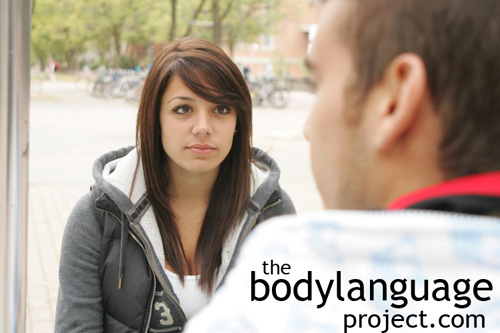Body Language of Running The Tongue Over The Teeth or Lips
 Cue: Running The Tongue Over The Teeth or Lips.
Cue: Running The Tongue Over The Teeth or Lips.
Synonym(s): Tongue To teeth, Licking The Teeth.
Description: When the tongue is run back and forth over the teeth or lips either with the mouth closed or mouth opened (rare). When the tongue is run back and forth across the teeth with the mouth closed, it shows up as only a bulge passing under the lips as the skin is forced out.
In One Sentence: Running the tongue over the teeth is a sign of the need for pacifying due to negative emotions.
How To Use it: Running the tongue over the teeth produces a comforting feeling. This cue generally goes unnoticed by most people so can be covertly used to pacify the mind.
Context: General.
Verbal Translation: “I’m running my tongue over my teeth or lips in order to creating a soothing sensation because I’m in need of pacifying due to anxiety.”
Variant: See Lip Licking, Leg Cleansing or Leg Pacifying Behaviour, Neck Rubbing (back of neck) or Holding The Back Of The Neck.
Cue In Action: a) His tongue darted in and out, sweeping left and right during his daily tasks inciting his underlying obsessive-compulsive disorder. b) A bulge formed under his front lips indicating that his tongue was sweeping his teeth. The salesman knew his final price wasn’t going to cut it.
Meaning and/or Motivation: At times, lip licking is a sexual cue, but when it is absent of other sexual cues in cluster, it signifies a need to pacify. When done to pacify, it is usually done repeatedly and rhythmically without eye contact. The tongue on teeth provides a soothing tactile stimuli aimed at reducing anxiety.
Often the cue happens just out of perception to a casual observer, but when watched for, can be quite pronounced. A person might sweep their teeth and enjoy the soft surface they provide while dealing with distress.
Habitual teeth lickers provide evidence that they harbor hidden underlying discomfort. The same can be said for habitual lip lickers who sweep their lips over and over again. As the tongue sweeps, it serves the same purpose as running the palms over the thighs, or rubbing the back of the neck, stroking the hands, rubbing the back of the head and so forth. These are all ways we pacify and sooth ourselves throughout the day as stress presents itself.
Cue Cluster: Watch for other pacifying behaviours such as rubbing the face, playing with the hair, stroking the arm or thighs, or hand or an object to the mouth.
Body Language Category: Auto contact or self touching, Autoerotic touching, Courtship display, Stroking body language, Indicators of sexual interest (IOsI), Pacifying body language, Stressful body language, Worry body language.
Resources:
Barroso, Felix ; Feld, Jason. Self-touching and attentional processes: The role of task difficulty, selection stage, and sex differences. Journal of Nonverbal Behavior. 1986. 10(1): 51-64.
Butzen, Nathan David ; Bissonnette, Victor ; Mcbrayer, Dan. Effects of modeling and topic stimulus on self-referent touching. Perceptual and motor skills. 2005. 101(2): 413-20.
Broome, Marion E.. Helping Parents Support Their Child In Pain. Pediatric Nursing. 2000. 26(3): 315.
Bornstein, Marc H. ; Tamis-Lemonda, Catherine S. Maternal responsiveness and infant mental abilities: Specific predictive relations. Infant Behavior and Development. 1997. 20(3): 283-296.
Buckley, V., & Semple, S. (2012). Evidence that displacement activities facilitate behavioural transitions in ring-tailed lemurs. Behavioural Processes, 90, 433–435.
Bernal, Gilda Rios ; Wortham, Suec. How to Calm Children through Massage. Childhood Education. 1997. 74(1): 9-14.
Bouhuys, A.L. ; Jansen, C.J. ; van den Hoofdakker, R.H. Analysis of observed behaviors displayed by depressed patients during a clinical interview: relationships between behavioral factors and clinical concepts of activation. Journal of Affective Disorders. 1991. 21(2): 79-88.
Bouhuys, A.L. ; Beersma, Domien G.M. ; van den Hoofdakker, Rutger H. Observed behavior as a predictor of the response to sleep deprivation in depressed patients. Psychiatry Research. 1989. 28(1): 47-61.
Berridge CW,Mitton E, ClarkW, Roth RH. 1999. Engagement in a non-escape (displacement) behavior elicits a selective and lateralized suppression of frontal cortical dopaminergic utilization in stress. Synapse 32:187–197.
Caplovitz Barrett, Karen. The origins of social emotions and self-regulation in toddlerhood: New evidence. Cognition & Emotion. 2005. 19(7): 953-979.
Castles, Duncan L. ; Whiten, Andrew ; Aureli, Filippo. Social anxiety, relationships and self-directed behaviour among wild female olive baboons. Animal Behaviour. 1999. 58(6): 1207-1215.
D’alessio, M. ; Zazzetta, A. Development of Self-Touching Behavior in Childhood. Perceptual and Motor Skills. 1986. 63(1): 243-253.
Everly, Jr., G. S. & Lating, J. M. (2002). A clinical guide to the treatment of the human stress response (2nd ed.). New York, NY: Kluwer Academic/Plenum Publishers
Karagozoglu, Serife ; Kahve, Emine. Effects of back massage on chemotherapy-related fatigue and anxiety: Supportive care and therapeutic touch in cancer nursing. Applied Nursing Research. 2013. 26(4): 210-217.
Goldberg, Shelly ; Rosenthal, Robert. Self-touching behavior in the job interview: Antecedents and consequences. Journal of Nonverbal Behavior. 1986. 10(1): 65-80.
Garnefski N 2004) Cognitive emotion regulation strategies and depressive symptoms: differences between males and female. Personal Indiv Diff 36: 267–76.
Huflejt-Łukasik M, Czarnota-Bojarska J (2006) Short Communication: Selffocused attention and self-monitoring influence on health and coping with stress. Stress Health 22: 153–59.
Hernandez-Reif, Maria ; Diego, Miguel ; Field, Tiffany. Preterm infants show reduced stress behaviors and activity after 5 days of massage therapy. Infant Behavior and Development. 2007. 30(4): 557-561.
Harrison, Lynda Law. The use of comforting touch and massage to reduce stress for preterm infants in the neonatal intensive care unit. Newborn and Infant Nursing Reviews. 2001. 1(4): 235-241.
Hennessy, Michael B ; T. Williams, Michael ; Miller, Deborah D ; Douglas, Chet W ; Voith, Victoria L. Influence of male and female petters on plasma cortisol and behaviour: can human interaction reduce the stress of dogs in a public animal shelter?
Applied Animal Behaviour Science. 1998. 61(1): 63-77.
Harrigan, Jinni A. Self-touching as an indicator of underlying affect and language processes. Social Science & Medicine. 1985. 20(11): 1161-1168.
Harrigan, Jinni A.; Karen S. Lucic; Denise Kay; Anne McLaney and Robert Rosenthal. Effect of Expresser Role and Type of Self-Touching on Observers’ Perceptions. Journal of Applied Social Psychology. 1991. 21(7): 585-609.
Heaven, Laura ; Mcbrayer, Dan ; Prince, Bob. Role of sex in externally motivated self-touching gestures. Perceptual and motor skills. 2002. 95(1): 289-94.
Heaven, L ; Mcbrayer, D. External motivators of self-touching behavior. Perceptual and motor skills. 2000. 90(1): 338-42.
Katza, Carmit; Irit Hershkowitz; Lindsay C. Malloya; Michael E. Lamba; Armita Atabakia and Sabine Spindlera. Non-Verbal Behavior of Children Who Disclose or do not Disclose Child Abuse in Investigative Interviews. Child Abuse & Neglect. 2012. 36: 12-20.
http://bodylanguageproject.com/articles/reading-nonverbal-behaviour-child-abuse-cases-encourage-children-divulge-information-truth-telling
Kochanska, G., Coy, K. C., & Murray, K. T. (2001). The development of self-regulation in the first four years of life. Child Development, 72, 1091–1111.
Kochanska, G., Murray, K. T., & Harlan, E. T. (2000). Effortful control in early childhood: Continuity and change, antecedents, and implications for social development. Developmental Psychology, 36, 220–232.
Moszkowski, Robin J. ; Stack, Dale M. ; Chiarella, Sabrina S. Infant touch with gaze and affective behaviors during mother–infant still-face interactions: Co-occurrence and functions of touch. Infant Behavior and Development. 2009. 32(4): 392-403.
Maestripieri D, Schino G, Aureli F, Troisi A. 1992. A modest proposal: displacement activities as an indicator of emotions in primates. Anim Behav 44:967–979.
Mohiyeddini, C., Bauer, S., & Semple, S. (2013a). Displacement behaviour is associated with reduced stress levels among men but not women. PLoS One, 8, e56355.
Mohiyeddini, C., Bauer, S., & Semple, S. (2013b). Public self-consciousness moderates the link between displacement behaviour and experience of stress in women. Stress, 16, 384–392.
Mohiyeddini, C., & Semple, S. (2013). Displacement behaviour regulates the experience of stress in men. Stress, 16, 163–171.
Marcus-Newhall A, Pedersen WC, Carlson M, Miller N. 2000. Displaced aggression is alive and well: a meta-analytic review. J Pers Soc Psychol 78:670–689. Ingram GIC. 1960. Displacement activity in human behavior. Am Anthropol. 62:994–1003.
Moore, Monica. Courtship Signaling and Adolescents: Girls Just Wanna Have Fun. Journal of Sex Research. 1995. 32(4): 319-328.
http://bodylanguageproject.com/articles/girls-just-want-to-have-fun-the-origins-of-courtship-cues-in-girls-and-women/
Nolen-Hoeksema S, Aldao A (2011) Gender and age differences in emotion regulation strategies and their relationship to depressive symptoms. Personal Indiv Diff 51: 704–8.
Navarro, Joe. 2008. What Every BODY is Saying: An Ex-FBI Agent’s Guide to Speed-Reading People. William Morrow Paperbacks.
Kirschbaum C, Pirke K-M, Hellhammer DH. 1993. The ‘Trier Social Stress Test’: a tool for investigating psychobiological stress responses in a laboratory setting. Neuropsychobiology 28: 76–81.
Pecora, Giulia ; Addessi, Elsa ; Schino, Gabriele ; Bellagamba, Francesca. Do displacement activities help preschool children to inhibit a forbidden action? Journal of Experimental Child Psychology. 2014. 126: 80-90.
Schaafsma, Juliette ; Krahmer, Emiel ; Postma, Marie ; Swerts, Marc ; Balsters, Martijn ; Vingerhoets, Ad. Comfortably Numb? Nonverbal Reactions to Social Exclusion. Journal of Nonverbal Behavior. 2015. 39(1): 25-39.
Schino G, Perretta G, Taglioni AM, Monaco V, Troisi A. 1996. Primate displacement activities as an ethopharmacological model of anxiety. Anxiety 2:186–191.
Supplee, Lauren H ; Skuban, Emily Moye ; Shaw, Daniel S ; Prout, Joanna. Emotion regulation strategies and later externalizing behavior among European American and African American children. Development and Psychopathology. 2009. 21(2): 393-415.
Smith, John, Julia Chase, and Anna Lieblich (1974). “Tongue Showing.” In Semiotica (Vol. 11, No. 3), pp. 201-46.
Stern, Daniel and Estelle Bender (1974). “An Ethological Study of Children Approaching a Strange Adult.” In Richard Friedman et al. (Eds.), Sex Differences in Behavior (New York: John Wiley and Sons), pp. 233-58.
Tamres L, Janicki D, Helgeson VS (2002) Sex differences in coping behaviour: a meta-analytic review. Personal Soc Psychol Rev 6: 2–30.
Troisi A (2002) Displacement activities as a behavioural measure of stress in nonhuman primates and human subjects. Stress 5: 47–54.
Troisi A (1999) Ethological research in clinical psychiatry: the study of nonverbal behaviour during interviews. Neurosci Biobehav Rev 23: 905–913.
Troisi A, Moles A (1999) Gender differences in depression: an ethological study
of nonverbal behaviour during interviews. J Psychiatr Res 33: 243–250.
Vannorsdall, Tracy ; Dahlquist, Lynnda ; Shroff Pendley, Jennifer ; Power, Thomas. The Relation Between Nonessential Touch and Children’s Distress During Lumbar Punctures. Children’s Health Care. 2004. 33(4): 299-315.
von Hippel W, von Hippel C, Conway L, Preacher KJ, Schooler JW, et al. (2005) Coping with stereotype threat: denial as an impression management strategy. J Personal Soc Psychol 89: 22–35.


